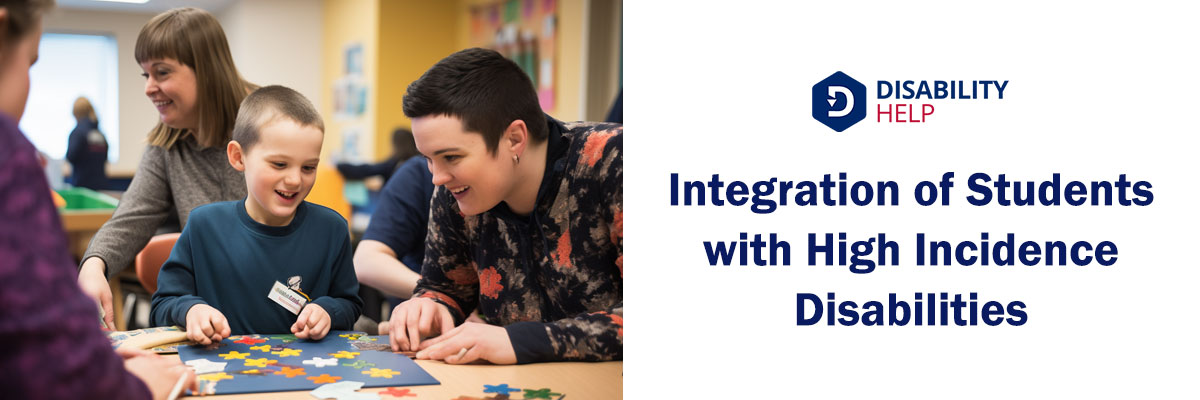High-incidence disabilities are a category of disabilities that are more commonly found among students in the education system.
Specific learning problems affect nearly 36% of students with disabilities served under the Individuals with Disabilities Education Act (IDEA).[1]
Students with high incidence disabilities often encounter difficulties with socialization, communication, and learning.
Physical therapists and occupational therapists play a vital role in helping students overcome physical challenges.[2]
Students grappling with emotional or behavioral disorders (E/BD), learning difficulties (LD), or mild intellectual disability constitute a significant portion of the high-incidence group.
High Incidence Disability, often deemed a mild disability, predominantly affects students with learning disabilities receiving special educationCustomized educational programs designed to meet the needs of students with disabilities. in schools. It's reported that specific learning problems touch nearly 36% of students with disabilities served under the Individuals with Disabilities Education Act (IDEA).[1] This blog aims to shed light on three common types of high-incidence disabilities: intellectual disabilityA disability characterized by significant limitations in both intellectual functioning and adaptive ..., learning disabilityA disorder in one or more of the basic processes involved in understanding or using language, spoken..., and emotional/behavioral disorder.
Integration of Students with High Incidence Disabilities

Students experiencing high-incidence disabilities are frequently incorporated into regular classrooms. This integration is where they spend a considerable portion of their academic time aside from learning in the classroom from a teacher.
These students are provided with accommodationsModifications or adjustments in healthcare settings to support patients with disabilities., modifications, and additional in-classroom services to facilitate a conducive learning environment. They're often assisted by paraprofessionals who reinforce the collective efforts to enhance the students' progression.
The Role of Specialists in Assisting Students
A network of specialists, such as pathologists, physical therapists, occupational therapists, and social workers, provides supplemental support to these students. Their services prove invaluable, particularly when students require additional assistance to navigate the complexities of their academic life. Pursuing a master in social work degree can empower individuals to join this dedicated network and play a vital role in enhancing the overall well-being and success of students facing academic and personal challenges.
The successful integration and development of students with high-incidence disabilities require the collective effort of a team of specialists. This team comprises pathologists, physical therapists, occupational therapists, and social workers. These professionals form an invaluable support network dedicated to enhancing the educational and life experiences of students with disabilities.
Fast Facts
About 36% of students with disabilities receive special education servicesEducational programs and services designed to meet the needs of students with disabilities. under the Individuals with Disabilities Education Act (IDEA).
Speech-Language Pathologists
Speech-language pathologists are pivotal in assisting students with communication disorders, which often accompany high-incidence disabilities. They diagnose and treat speech, language, and swallowing disorders, making significant contributions to the overall well-being of these students. These professionals also equip students with the communication skills necessary to interact effectively with peers, bolstering their social integrationThe process of enabling individuals with disabilities to participate fully in society, including in ....
Physical and Occupational Therapists
Physical therapists and occupational therapists play a vital role in helping students overcome physical challenges.[2] They provide therapeutic interventions to enhance mobility, improve fine motor skills, and foster independence in daily tasks. Their specialized skills ensure students can participate in school activities to the best of their abilities, promoting inclusivity.
Social Workers
School social workers serve a unique role by providing emotional and social support. They liaise with students, teachers, parents, and the community, addressing a range of issues that may impact a student's learning and overall well-being. They are pivotal in crisis intervention, counselingProfessional guidance to help individuals cope with emotional, mental, or social challenges, particu..., and connecting families with necessary resources.
The role of these specialists becomes increasingly vital in catering to the unique needs of this significant student population. With their unique expertise, these specialists work in tandem to provide a well-rounded support system for students with high incidence disabilities. Their collaborative efforts facilitate academic learning and the essential life skills that empower students to navigate their unique life challenges confidently.
Challenges Faced by Students with High Incidence Disabilities
Students with high incidence disabilities often encounter difficulties with socialization, communication, and learning, which impact their academic performance. A prevalent form of high incidence disability is speech and language impairmentA loss or abnormality of a body structure or function, whether physical, mental, or sensory, often a..., also called communication disorders.
The detection of such disabilities in students can be challenging, usually becoming apparent once the student begins to struggle in a school environment. Teachers may observe unusual behavior patterns, distinguishing them from their peers, prompting a closer investigation. It's crucial for educators, parents, and peers to acknowledge and understand the diverse forms these struggles and health issues in students can manifest.
Diverse Manifestations of High Incidence Disabilities
High incidence disabilities can present in several ways. Students grappling with emotional or behavioral disorders (E/BD), learning difficulties (LD), or mild intellectual disability often constitute a significant portion of the high incidence group in school statistics.
Recently, there has been an uptick in detecting various disabilities like high-functioning autism, attention deficit hyperactivity disorder, and speech and language impairments. These are increasingly grouped under an umbrella category known as "other" among high incidence disabilities.
Recognizing and understanding these characteristics can lead to the formulation of more effective strategies and support systems. This understanding can greatly improve the educational experiences and outcomes of students with high incidence disabilities.
Fast Facts
Majority of students with high-incidence disability suffers from emotional or behavioral disorders (E/BD), learning difficulties (LD), or mild intellectual disability.
Frequently Asked Questions:
What are high incidence disabilities?
High-incidence disabilities are a category of disabilities that are more commonly found among students in the education system. They typically include learning disabilities, mild intellectual disabilities, emotional and behavioral disorders, and speech or language impairments.
How do high incidence disabilities impact students' learning experiences?
High-incidence disabilities can affect various aspects of a student's learning, such as reading, writing, communication, and behavior. These challenges may require specialized instruction, accommodations, or interventions to support the student's academic progress and social-emotional development.
What support services are available for students with high incidence disabilities?
Schools may provide support services such as special education, Individualized Education Programs (IEPs), and accommodations in the general education classroom. Additional support may include speech and language therapyTherapy focused on improving communication skills, including speech, language, and swallowing., occupational therapy, counseling, and specialized instructional strategies tailored to meet the individual needs of the student.
How can parents and teachers help students with high incidence disabilities?
Parents and teachers can assist by identifying early signs, implementing personalized learning plans, creating inclusive environments, using assistive technologies, and promoting consistent communication and collaboration.
Where can I find additional resources for high incidence disabilities?
Resources can be found on websites like the National Center for Learning Disabilities, Understood.org, or the Council for Exceptional Children. Parent support groups and professional counselors are also valuable resources.
People often mix up learning disabilities and autism, and while the two may appear to be similar, they are really different in many respects. Read the Disability Help blog to learn how to tell the difference between autism and learning disabilities.
- “Statute and Regulations.” Individuals With Disabilities Education Act, 2023, https://sites.ed.gov/idea/statuteregulations/
- “About Occupational Therapy.” American Occupational Therapy Association, 2023, https://www.aota.org/About-Occupational-Therapy/Professionals/OT.aspx






